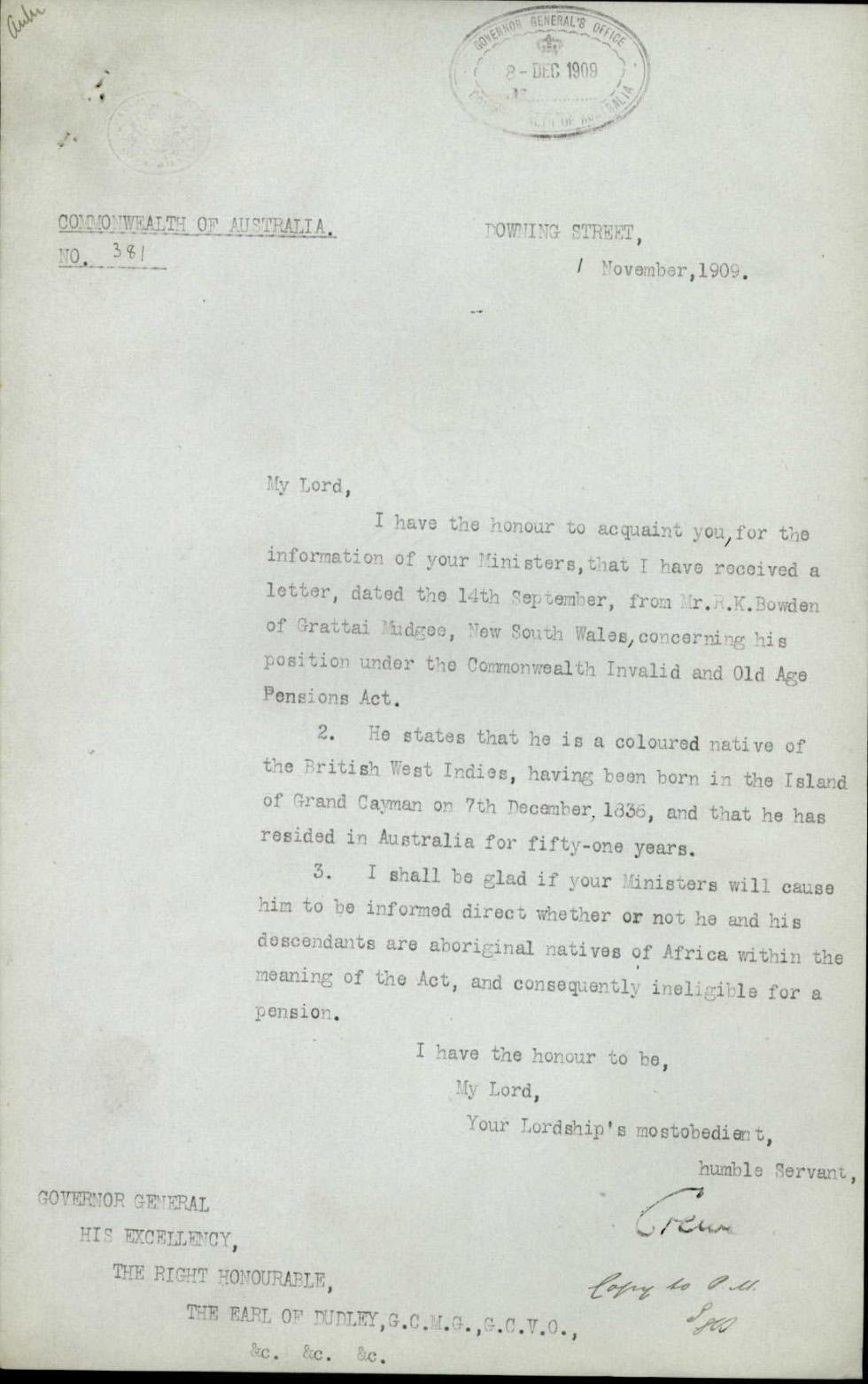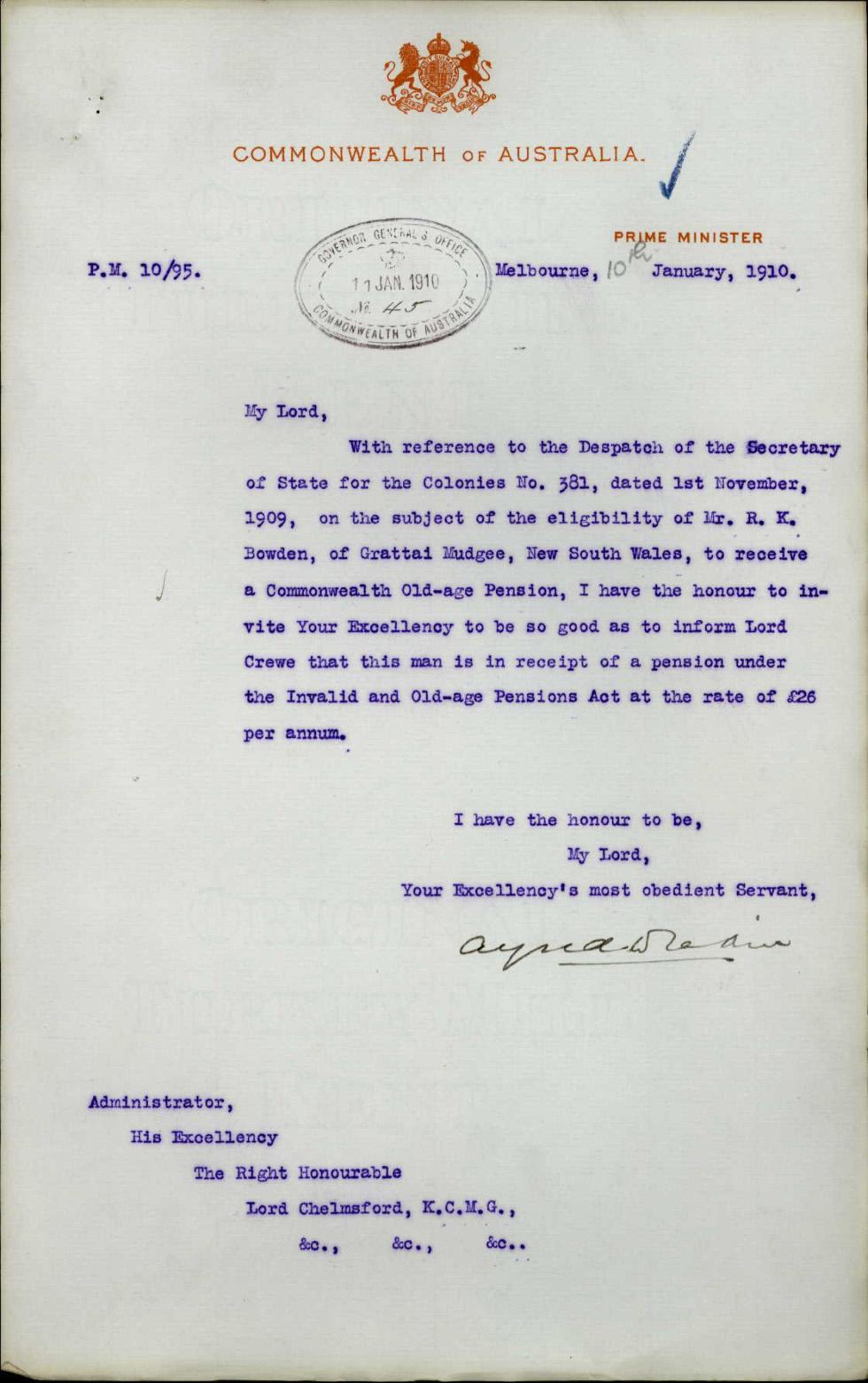

Aboriginal and Torres Strait Islander people should be aware that the National Archives' website and collection contain the names, images and voices of people who have died.
Some records include terms and views that are not appropriate today. They reflect the period in which they were created and are not the views of the National Archives.



[Page 1]
[Oval shaped black stamp slightly to the right of the middle at the top page.]
[Top border of the stamp reads: GOVERNOR GENERAL’S OFFICE]
[Bottom border of the stamp largely indistinguishable due to fading, final word reads: AUSTRALIA]
[In the middle of the stamp is a faded crown and beneath the crown the date reads: 8 – DEC 1909]
[Faded stamp on the top left of page is illegible.]
[Subheading on left of page reads: COMMONWEALTH OF AUSTRALIA
NO. [the following is hand written] 381]
[Right-hand side reads: DOWNING STREET, [the following number is hand written] 1 November 1909.]
My Lord,
I have the honour to acquaint you, for the information of your Ministers, that I have received a letter, dated the 14th September, from Mr. R.K.Bowden of Grattai Mudgee, New South Wales, concerning his position under the Commonwealth Invalid and Old Age Pensions Act.
2. He states that he is a coloured native of the British West Indies, having been born on the Island of Grand Cayman on 7th December 1936, and that he has resided in Australia for fifty-one years.
3. I shall be glad if your Ministers will cause him to be informed direct whether or not he and his descendants are aboriginal natives of Africa within the meaning of the Act, and consequently ineligible for a pension.
I have the honour to be,
My Lord,
Your Lordship's mostobedient, [sic]
humble Servant
[Illegible handwritten signature in bottom right corner.]
[Bottom left corner reads: GOVERNOR GENERAL
HIS EXCELLENCY,
THE RIGHT HONOURABLE,
THE EARL OF DUDLEY, G.C.M.G.,G.C.V.O,
&c. &c. &c.]
[Page 2]
[British coat of arms in red ink top middle of page.]
[Heading in the middle of page in red ink reads: COMMONWEALTH OF AUSTRALIA.]
[Thick handwritten blue tick to the left, slightly beneath heading.]
[On right side beneath tick red typed ink reads: PRIME MINISTER]
[Oval shaped black stamp slightly to the left of the middle of the page beneath heading.]
[Top border of the stamp reads: GOVERNOR GENERAL'S OFFICE]
[Bottom border of the stamp reads: COMMONWEALTH OF AUSTRALIA]
[Illegible symbol in the middle of stamp.]
[Date beneath symbol in the middle of stamp reads: 11 JAN. 1910
No. [the following number is handwritten in black ink] 45]
[The letter is typed in purple ink.]
P.M. 10/95.
Melbourne, [the following number is handwritten in pencil] 10th January, 1910.
My Lord,
With reference to the Despatch of the Secretary of State for the Colonies No. 381, dated 1st November, 1909, on the subject of the eligibility of Mr. R. K. Bowden, of Grattai Mudgee, New South Wales, to receive a Commonwealth Old-age Pension, I have the honour to invite Your Excellency to be so good as to inform Lord Crewe that this man is in receipt of a pension under the Invalid and Old-age Pensions Act at the rate of £26 per annum.
[The following is typed on the right-hand side of the page.]
I have the honour to be,
My Lord,
Your Excellency's most obedient Servant,
[Illegible signature written in black ink and underlined.]
[Bottom right corner reads: His Excellency
The Right Honourable
Lord Chelmsford, K.C.M.G.,
&c., &c., &c..]
In this letter, advice is requested from the Governor-General about a man’s eligibility for the ‘old-age’ pension. The Invalid and Old-age Pensions Act 1908 created the first social security benefits at a national level in Australia.
Before Federation, people who were not physically or mentally able to work were reliant on family or charity to survive. Some of the colonies provided limited welfare support, often in the form of institutional care.
During the 1890s depression, a number of political parties emerged from the trade union movement (which later became the Labor Party). These parties argued that social policies were necessary to counter the injustices created by unregulated capitalism. There was widespread support for an ‘old-age’ pension, as it was considered to be a reward for a lifetime of hard work. Due to this support, the drafters of the Constitution allowed the Commonwealth to make policies in this area.
After Federation, the newly established Labor Party campaigned on a range of policies including ‘White Australia’ and pensions. In 1908 Prime Minister Alfred Deakin’s Protectionist Party formed a minority government with the support of the Labor Party. Labor supported Deakin’s government on the condition that it would legislate to establish an ‘invalid and old-age pension’. In keeping with both parties’ platforms, only white Australians were eligible.
In the original Act, home ownership was included in means-testing, which meant that many people who owned their own home were unable to receive the pension. Opposition Labor leader Andrew Fisher disputed this and later, when Fisher became Prime Minister, he removed this barrier so that pensions would be more accessible.
The Invalid and Old-age Pensions Act 1908 provided a means-tested pension to people over the age of 16 who were unable to work due to injury or disability, as well as to men over 65 and women over 60. In 1908, a much smaller proportion of the population was eligible for the pension than today because life expectancy was much lower: the average life expectancy for both men and women was less than 60 and only 4 per cent of the population were over 65. The Act entitled older people and people with disabilities to a maximum of 26 pounds per annum (which is the equivalent of approximately $3500 per annum in 2020).
The Invalid and Old-age Pension Act 1908 was the first piece of legislation in the development of the Australian welfare state. Since 1908, the Australian Government has continued to fund other forms of pension to meet the needs of Australians.
Learn how to interpret primary sources, use our collection and more.
